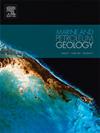Facies analysis of gravity-flow deposits from the Upper Cretaceous of the Alborz Mountains (northern Iran)
IF 3.7
2区 地球科学
Q1 GEOSCIENCES, MULTIDISCIPLINARY
引用次数: 0
Abstract
Field studies of sedimentary successions complemented by petrographic analyses allow distinctions among sub-environments, even in the case of subtle differences in geometry, structure, and composition. In three apparently uniform sections of the coarse-grained siliciclastic K2b unit of Upper Cretaceous age exposed in the southern central Alborz Mountains (northern Iran), careful observations of texture, fabric, composition, and bed thickness have allowed the identification of eight petrofacies, twelve low-rank facies associations, and six high-rank facies associations. The coarse grain size of the K2b unit, the radial paleocurrent pattern indicated by grain orientation, along with the presence of hummocky and swaley cross-stratification, glaucony, Skolithos ichnofacies, and Hedbergellidae planktonic foraminifera suggest a fan-delta prograding onto a shallow shelf. Conglomerate layers, erosion surfaces, plane beds, and oriented grains point to diverse depositional mechanisms, including cohesive debris flows, hyperconcentrated flows, and turbidity currents. Sediment-gravity flows in the K2b unit, generated along the southern margin of the Proto-south Caspian basin, testify to both relative sea-level fall and tectonic uplift in mountainous source areas.
伊朗北部Alborz山脉上白垩统重力流沉积相分析
对沉积序列的实地研究加上岩石学分析,可以区分亚环境,即使在几何、结构和组成上存在细微差异的情况下也是如此。在伊朗北部Alborz山脉中南部的上白垩统粗粒硅屑K2b单元的三个表面均匀的剖面中,通过对结构、组份、成分和层厚的仔细观察,确定了8个岩相,12个低阶相组合和6个高阶相组合。K2b单元的粗粒度、颗粒取向指示的径向古流格局、丘状和沟壑交叉层理、海绿石、Skolithos海相和Hedbergellidae浮游有孔虫的存在表明其为一个向浅陆架推进的扇三角洲。砾岩层、侵蚀面、平面层和定向颗粒指向不同的沉积机制,包括粘性碎屑流、高浓度流和浊度流。K2b单元沿原南里海盆地南缘形成的沉积重力流,证明了山区源区的相对海平面下降和构造隆升。
本文章由计算机程序翻译,如有差异,请以英文原文为准。
求助全文
约1分钟内获得全文
求助全文
来源期刊

Marine and Petroleum Geology
地学-地球科学综合
CiteScore
8.80
自引率
14.30%
发文量
475
审稿时长
63 days
期刊介绍:
Marine and Petroleum Geology is the pre-eminent international forum for the exchange of multidisciplinary concepts, interpretations and techniques for all concerned with marine and petroleum geology in industry, government and academia. Rapid bimonthly publication allows early communications of papers or short communications to the geoscience community.
Marine and Petroleum Geology is essential reading for geologists, geophysicists and explorationists in industry, government and academia working in the following areas: marine geology; basin analysis and evaluation; organic geochemistry; reserve/resource estimation; seismic stratigraphy; thermal models of basic evolution; sedimentary geology; continental margins; geophysical interpretation; structural geology/tectonics; formation evaluation techniques; well logging.
 求助内容:
求助内容: 应助结果提醒方式:
应助结果提醒方式:


